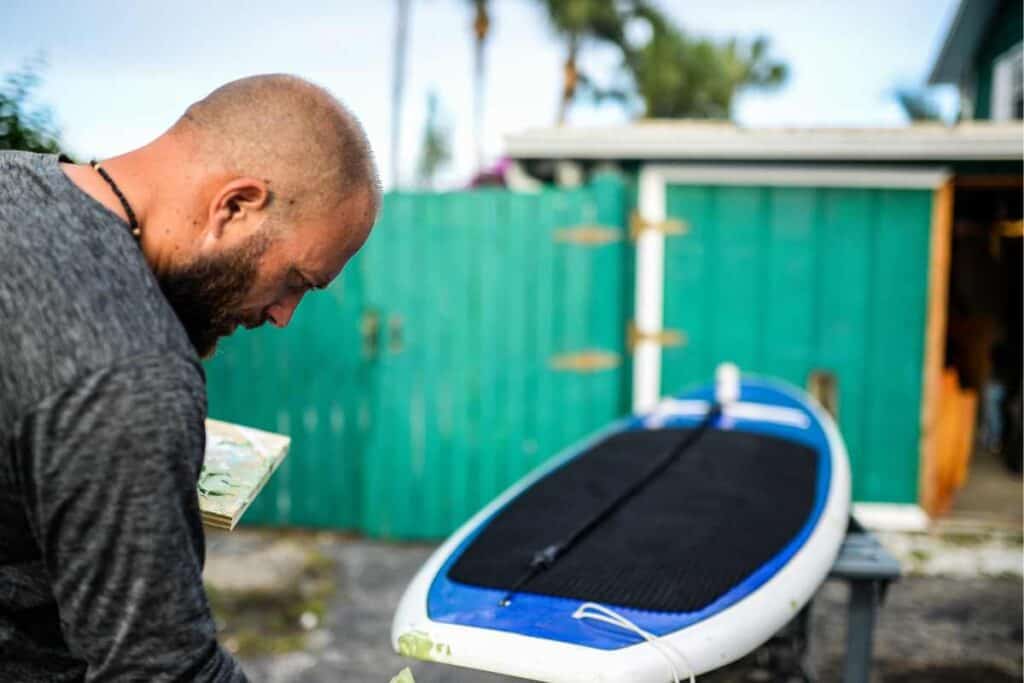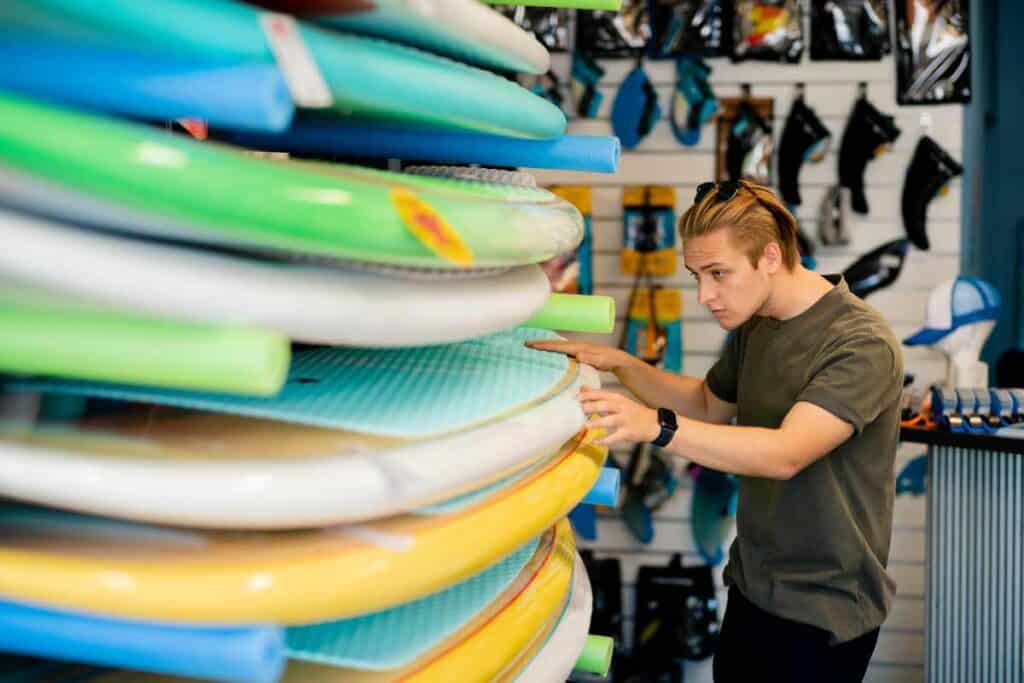In the world of surfing, choosing the right surfboard can make all the difference in your experience on the water.
One important decision surfers face when selecting a board is whether to opt for a soft top or an epoxy surfboard.

Both types of surfboards offer unique advantages, and understanding the key differences between them can help surfers find the perfect board for their needs.
- Soft top surfboards, also known as foam surfboards, are specifically designed to provide a softer, more forgiving surface for beginners learning the sport. These boards are known for their durability and affordability, making them a popular choice among surf schools and novices alike.
- In contrast, epoxy surfboards, which boast a rigid construction with an EPS foam core and epoxy resin finish, are known for their lightweight and snappy performance on the water. Epoxy boards typically appeal to more experienced surfers looking for speed and agility in their ride.
As surfers become more familiar with their preferences and skill level, the choice between soft top and epoxy surfboards will depend on various factors such as:
- riding style
- wave conditions
- and personal comfort
By comparing the characteristics and performance of each surfboard type, every surfer can find the ideal balance for their time on the waves.
Soft Top Surfboards

Construction
Soft top surfboards, also known as foam surfboards or foamies, have a smooth, spongy, cushioned deck. Their construction consists of a soft EVA foam deck on top and a durable epoxy build on the bottom.
This provides surfers with a mix of soft top and epoxy board characteristics, offering a comfortable and forgiving surface with increased durability and performance.
Advantages
Some advantages of soft top surfboards include:
- User-friendly: The soft, cushioned surface makes these boards ideal for beginners and individuals learning to surf, as they are more forgiving and comfortable to ride.
- Safety: The soft material reduces the chances of injuries caused by the board during wipeouts, making it a safer option than traditional hard surfboards.
- Durability: Soft top surfboards are known for being virtually indestructible, as their foam construction can withstand more impact and wear than fiberglass or epoxy boards.
- Affordability: These boards are often less expensive than traditional surfboards, making them an attractive option for surfers of all levels.
Disadvantages
However, soft top surfboards also come with some disadvantages:
- Performance limitations: Although progressing surfers may find some soft top boards with performance-oriented shapes, they generally lack the same level of performance as traditional epoxy or fiberglass boards due to their softer construction.
- Weight: Soft top surfboards can be heavier than their epoxy or fiberglass counterparts, which may result in slower rides and reduced maneuverability.
- Less eco-friendly: The foam material used in soft top surfboard construction may not be as environmentally friendly as some other materials, such as wood or eco-epoxy.
Overall, soft top surfboards offer a combination of user-friendly features, safety, durability, and affordability, making them an appealing choice for beginner surfers or those looking for a versatile, cost-effective option.
However, they come with some performance limitations and potential environmental concerns.
Epoxy Surfboards

Construction
Epoxy surfboards are constructed using an Expanded Polystyrene (EPS) foam core, covered with layers of fiberglass and epoxy resin.
This combination results in a strong and lightweight surfboard with higher buoyancy in the water.
The process of constructing epoxy surfboards generally involves the shaping of the EPS foam core, followed by laminating it with layers of fiberglass and epoxy resin.
Advantages
Epoxy surfboards provide several advantages over traditional polyurethane (PU) and soft-top surfboards:
- Lightweight: Due to the use of EPS foam and epoxy resin, epoxy surfboards are typically lighter than their PU counterparts. This helps surfers achieve faster speeds and maneuverability on the waves.
- Stronger and more durable: The combination of EPS foam, fiberglass, and epoxy resin creates a strong and durable construction, making epoxy surfboards more resistant to dings, cracks, and waterlogging.
- Better buoyancy: The lighter EPS foam provides better buoyancy, allowing surfers to catch waves more easily. This can be particularly helpful for beginner surfers who are still learning to balance and paddle on a surfboard.
- Faster: The lightweight and strong construction of epoxy surfboards make them capable of achieving higher speeds on the water, which allows for more aggressive maneuvers and turns.
Disadvantages
While epoxy surfboards have several benefits, they also come with some drawbacks:
- Flexibility: Compared to traditional PU boards, epoxy surfboards may have a stiffer feel due to the stronger construction materials. Some surfers prefer the flex of PU boards as it allows for a smoother, more responsive ride.
- Price: Epoxy surfboards can be more expensive than their PU counterparts, especially if they use high-quality materials and unique design features. However, the increased durability can make them a worthwhile investment for many surfers.
- Temperature sensitivity: Epoxy surfboards can be more sensitive to high temperatures than PU boards. If not stored or handled correctly, excess heat can cause damage to the epoxy resin, compromising the structure of the board.
Comparing Performance

Wave Conditions
Soft-top surfboards and epoxy surfboards each perform differently in various wave conditions.
- Soft-top foam surfboards, also known as foamies, are typically more buoyant due to their construction. They feature a soft foam layer, making them more forgiving and comfortable when paddling and catching small to medium-sized waves.
- Epoxy surfboards, on the other hand, offer more responsiveness and maneuverability in a wider range of conditions, including bigger and more powerful waves.
While soft-top surfboards are perfect for catching smaller waves and offering a gentle and stable ride, epoxy surfboards allow surfers to make sharper turns and perform more advanced maneuvers.
Their stiffer construction provides more speed and drive, making them suitable for intermediate to advanced riders looking to improve their skills.
Skill Level
When considering the skill level of a surfer, soft-top foam surfboards are ideal for beginners due to their forgiving nature and ease of use.
These boards have ample width and overall volume, which translates to more stability and increased buoyancy, making it easier to learn the basics of surfing and catching waves.
The soft foam layer on the deck also provides a comfortable and safe platform, reducing the risk of injury for new surfers. Some recommended beginner soft-top surfboards are the 8ft-9ft Stormblade SSR soft top surfboard and the Degree33 Poacher.
Meanwhile, epoxy surfboards are geared toward intermediate and advanced surfers who seek more performance-driven boards. These surfboards allow for tighter turns, snappier maneuvers, and enhanced control in a variety of wave conditions.
Epoxy surfboards also tend to be more durable, as they are constructed with an epoxy resin infused into fiberglass. This results in a lightweight and strong board that can withstand the rigors of more demanding surf sessions. Some notable epoxy surfboards for intermediate to advanced surfers include Degree33 The Ultimate Longboard and Torq TET Longboard.
In conclusion, soft-top surfboards and epoxy surfboards cater to different skill levels and wave conditions. Soft-tops are beginner-friendly, offering stability and a forgiving platform, while epoxy boards provide increased performance capabilities for those looking to advance their skills in more challenging conditions.
Maintenance and Durability

When comparing soft top surfboards and epoxy surfboards, it is important to consider the maintenance and durability of each type.
- Soft top surfboards have a top layer made of a soft and dentable Ethylene-Vinyl Acetate (EVA) sheet. This material is found in exercise mats, sneaker insoles, yoga blocks, and kick boards. Due to the nature of this material, soft top surfboards are generally easier to maintain as they are less prone to dings and scratches. Additionally, the soft top boards are more forgiving for beginner surfers who may accidentally collide with the surfboard during the learning process.
- On the other hand, epoxy surfboards are constructed with a durable epoxy resin and an EPS foam core. This combination makes them lightweight, strong, and resistant to damage. Epoxy surfboards typically last longer, are resistant to waterlogging, and are excellent choices for airport travel or handling surf conditions. The buoyancy of epoxy surfboards is enhanced due to the open-cellular nature of EPS foam blanks which contribute to their overall performance.
In terms of durability, epoxy surfboards are usually a better choice in comparison to soft top surfboards.
However, it is essential to consider the trade-off between performance and durability. Epoxy surfboards with higher flex for better performance might be slightly less durable than those with lower flex but are constructed to be more “bullet-proof.”
As a result, it is crucial to determine the surfer’s skill level and needs before deciding on the type of surfboard for optimal performance and reliability.
In conclusion, both soft top and epoxy surfboards have their advantages and disadvantages when it comes to maintenance and durability.
Soft top surfboards require less maintenance and provide a safer learning environment for beginners, while epoxy surfboards offer more durability, resistance to damage, and enhanced performance for advanced surfers. Understanding these differences will help guide surfers to the right choice for their unique needs and preferences.
Price Comparison
When comparing soft top surfboards and epoxy surfboards, it’s essential to consider the price, as it plays a significant role in your decision-making process.
Generally, soft top surfboards are more affordable than epoxy surfboards.
This is mainly due to the materials and manufacturing process involved in making each type of board.
- Soft Top Surfboards: Soft top surfboards are constructed with a soft, foam material on the surface, making them beginner-friendly and budget-friendly. Some popular soft top surfboards on the market include the Wavestorm 8′ at around $200 and the Foamy 8′ Gunner for approximately $375. Other options, such as the Odysea Catch Surf Skipper Quad J.O.B. Pro 5’6″-6’6″, come in at around $349, while the Softech Eric Geiselman Flash FCS II Surfboard 5′-7′ retails for about $380.
- Epoxy Surfboards: Epoxy surfboards feature a durable, lightweight construction using an EPS foam core and an epoxy resin coating. As a result, these boards are generally more expensive compared to their soft top counterparts. Epoxy surfboard prices vary greatly depending on factors like brand, size, and performance features. However, you can expect to pay at least $400 to $800 for a good-quality epoxy surfboard.
Read later – Gerry Lopez Soft Top vs Wavestorm
When comparing their respective costs, keep in mind that epoxy surfboards are often a better investment for intermediate to advanced surfers seeking a higher-performing, long-lasting board.
In contrast, soft top surfboards provide a more cost-effective option for beginners or more casual surfers who prioritize comfort and safety on the waves.
Making a Decision

When deciding between a soft top and an epoxy surfboard, it’s essential to consider your skill level, the type of waves you’ll be surfing, and your personal preferences.
Both soft top and epoxy surfboards have unique benefits and drawbacks, so understanding their characteristics will help you make an informed decision.
A soft top surfboard is an excellent option for beginners. The soft foam construction provides a stable and forgiving platform for learning, reducing the risk of injury when wiping out.
Additionally, these boards have a high buoyancy, making it easier to catch small and mushy waves. However, they might not be suitable for advanced surfers looking for more performance and maneuverability.
On the other hand, epoxy surfboards are crafted with expanded polystyrene (EPS) foam, fiberglass cloth, and epoxy resin. This combination creates a lighter and more durable board, suitable for various skill levels.
These surfboards have a higher buoyancy, making them easier to paddle and catch waves. They are also stiffer and more responsive, allowing for sharper turns and improved performance.
Some factors to consider when choosing between a soft top and an epoxy surfboard are:
- Skill level: Beginners may benefit from the stability and forgiving nature of a soft top surfboard. Intermediates and advanced surfers might prefer the performance and maneuverability of an epoxy board.
- Wave conditions: Soft top surfboards are ideal for small, mushy waves, while epoxy surfboards can handle a wider range of conditions.
- Durability: Epoxy surfboards are known for their durability and resilience, whereas soft top surfboards may be more prone to wear and tear.
- Buoyancy: Both soft top and epoxy surfboards offer high buoyancy, but epoxy boards generally have a slight edge due to their EPS foam core.
Ultimately, the choice between a soft top and an epoxy surfboard comes down to your personal preferences and needs.
Assessing your skill level, the waves you plan to ride, and the performance characteristics you desire in a board will help guide you to the perfect surfboard for your surfing adventures.
Frequently Asked Questions

What are the main differences between soft top and epoxy surfboards?
Soft top surfboards have an EPS foam core wrapped in either fiberglass or a synthetic wrap with a soft, dentable Ethylene-Vinyl Acetate (EVA) sheet as the top layer. Epoxy surfboards also have an EPS foam core but are wrapped in fiberglass and have a hardened epoxy resin as the top layer. The materials used in each type of surfboard result in different performance characteristics and durability.
Which type of surfboard is better for beginners?
For beginners, a soft top surfboard is generally preferred because it provides a fun, stable, and safe way to learn the basics of surfing. The soft top offers more grip and cushioning, which can prevent injuries during the learning process. In contrast, epoxy surfboards are stiffer and can be harder for beginners to maneuver.
Do soft top surfboards last as long as epoxy ones?
Durability varies between individual boards, but generally speaking, epoxy surfboards tend to be more durable than soft top surfboards. Epoxy boards are known for being lighter, stronger, and faster, which can result in a longer lifespan if they are well-maintained. However, soft top surfboards can still provide a decent lifespan if cared for properly.
What are the performance differences between soft top and epoxy boards?
Epoxy surfboards are known for their lightweight properties, buoyancy, and stiffness, making them more responsive and faster compared to soft top boards. This responsiveness makes them better suited for experienced surfers or for those looking to progress their skills. On the other hand, soft top surfboards offer a safer and more forgiving ride, which is ideal for beginners or those looking for a more relaxed surfing experience.
Can both types of surfboards be used in various wave conditions?
Yes, both soft top and epoxy surfboards can be used in a variety of wave conditions. However, their performance will be different due to the materials and construction used. Soft top surfboards are more suitable for smaller, softer waves where their buoyancy and stability can help in catching waves more easily. Epoxy surfboards are stiffer and more responsive, making them a better choice for more advanced surfers or for tackling larger, more powerful waves.
Is there a significant weight difference between soft top and epoxy surfboards?
Epoxy surfboards are typically lightweight due to the EPS foam core and epoxy resin construction. While soft top surfboards also use an EPS foam core, the addition of the soft EVA top layer can make them slightly heavier than their epoxy counterparts. However, this weight difference is generally not significant enough to drastically affect the performance of the surfboard.


